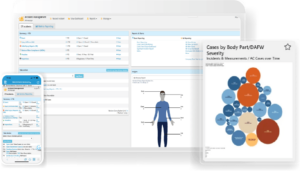The manufacturing sector in India employs over 35.6 million people as of FY 2023 and is on the brink of transformation driven by technological advancements, shifting global dynamics, and the need for improved safety standards. As the country aims to strengthen its manufacturing capabilities and become a global hub, prioritizing operational safety and adopting reliable EHS software for manufacturing is essential.
The Occupational Safety, Health, and Working Conditions Code, 2020 (OSH Code) is one of three new labor codes that will consolidate the bulk of labor legislation in India to streamline labor compliance and expand the social security net for workers. It simplifies business compliance while ensuring worker safety, streamlining multiple regulations into a single framework. One of the many compliance requirements under the code is to
“provide and maintain, as far as is reasonably practicable, a working environment that is safe and without risk to the health of the employees”
The OSH code details various workplace risk factors, prevention methods, and provisions that employers must adhere to. Given the scale of manufacturing plants, ensuring worker health and lifting operational safety is a mammoth task that can only be fulfilled by adopting advanced EHS safety solutions.
Fortunately, the emerging concepts of Industry 4.0 and Industry 5.0 represent distinct phases in manufacturing. While Industry 4.0 focuses on digital integration and automation, Industry 5.0 emphasizes collaboration between humans and machines, fostering creativity and customization. EHS 4.0 leverages advanced technologies like IoT (Internet of Things), AI (Artificial Intelligence), mobile, and other solutions to enhance safety operations by providing real-time insights and automated processes. Benchmark Gensuite’s EHS solutions are at the forefront of these advancements and actively embracing both the ongoing developments of Industry 4.0 and the emerging trends of Industry 5.0.
Let’s explore some of the prominent technologies that are digitally supporting and promoting safety operational in manufacturing:
AI in EHS
Artificial intelligence and its associated components occupy a large canvas of digital technology, offering a lot on the EHS front, too. AI in EHS automates risk assessments by quickly processing large volumes of data to identify trends and potential hazards. Real-time monitoring with AI helps safety violations and potential hazards using cameras and sensors, enabling immediate intervention. With AI tech in ergonomics, organizations can leverage AI-powered video-based assessments to detect risks in posture, movement, and motions. This provides you with insights to establish corrective actions, leading to improved worker safety and productivity.
AI’s ability to detect accidents through advanced data analysis allows for proactive intervention, creating a significant leap forward in EHS technologies for manufacturing.
Internet of Things for Operational Safety
In Industry 4.0, IoT focuses on automation and efficiency. Sensors collect real-time data on equipment performance, production lines, and even environmental conditions. This data is then analyzed to optimize processes, predict maintenance needs, and identify potential problems before they occur.
Industry 5.0 takes things a step further by fostering collaboration between humans and machines. Workers can access real-time data and insights directly on their mobile devices, enabling them to make informed decisions and work seamlessly with robots or automated systems. Additionally, advanced analytics from IoT data can be used to improve sustainability efforts within manufacturing. So, IoT acts as the nervous system of Industry 4.0 and Industry 5.0, providing a constant stream of data that fuels efficiency, collaboration, and progress.
IoT connects various devices through sensors, enabling continuous monitoring of environmental conditions within a manufacturing facility. This connectivity allows for real-time data collection and immediate analysis, which is crucial for identifying potential hazards and ensuring compliance with safety regulations. The ability to monitor factors such as temperature, humidity, and air quality continuously helps in maintaining a safe working environment and preventing incidents before they occur.
For instance, wearable sensor technology could monitor worker fatigue or exposure to harmful substances, enabling real-time interventions.
EHS Safety and Mobile Technologies
Mobile technology is a game-changer for Industry 4.0 and Industry 5.0. It provides crucial connectivity for real-time data access, remote monitoring, and AR applications. In Industry 5.0, mobile devices become even more sophisticated, fostering human-machine collaboration through data visualization and AI-powered insights. They’ll also be key for remote collaboration and promoting sustainable practices in manufacturing.
The flexibility of mobile capabilities allow employees to report incidents or hazards instantly from anywhere within the facility. Communication becomes quicker during emergencies or inspections, ensuring that pressing safety issues are addressed then and there. Mobile apps can also be used for conducting safety audits, training modules, and accessing critical information on-the-go, which speeds up response times for incident management and improves overall operational efficiency.
EHS Software Analytics and Reporting
Proper dashboard analytics and reporting are essential for enhancing EHS safety activities. They facilitate effective risk management by identifying hazards and utilizing predictive analytics to prevent incidents. Compliance monitoring becomes more efficient with automated reporting and continuous gap analysis, ensuring adherence to regulations. Incident management is improved through detailed root cause analysis and tracking of corrective actions, which helps prevent recurrence.
Additionally, dashboards assess training effectiveness, highlight areas needing further education, and optimize resource allocation by focusing on high-risk areas identified through data analysis. Environmental impact tracking supports compliance and sustainability initiatives by accurately monitoring emissions. Overall, analytics and reporting create safer work environments, ensure compliance, optimize resource use, and enhance EHS performance through informed decision-making.
Remote Collaboration
Remote collaboration in modern manufacturing is streamlined through advanced digital platforms, allowing seamless connections with remote or on-location experts and peers for audits, inspections, or maintenance checks. These platforms enable users to share information directly from their desktop or mobile applications, ensuring that critical tasks can be performed efficiently regardless of geographical constraints.
Integrated technologies such as real-time video sharing, audio communication, and instant chat features enhance visibility and communication efforts, facilitating a more cohesive and informed approach to safety operations. For example, U Connect allows users to have eyes and ears on-site from a remote or work-from-home environment through audio sharing, live video feeds, and instant messaging capabilities. By leveraging these advanced collaborative technologies, organizations can ensure that safety protocols are maintained effectively while enhancing overall operational efficiency.
Seamless Integration with Application Programming Interfaces (APIs)
Making well-informed, business-critical decisions backed by operational and performance data requires maximum visibility into all your cross-functional systems. However, many organizations still operate with disparate systems that can’t integrate with one another—resulting in fragmented workflows and a limited view of organizational data.
APIs could foster greater interoperability between EHS solutions from different vendors. Imagine manufacturing facilities using a mix of EHS software for specific tasks. APIs would allow these systems to “talk” to each other, creating a unified EHS ecosystem where data flows freely and eliminates information silos. This two-way communication could provide valuable insights for EHS professionals. For example, production data could be analyzed to identify processes with higher safety risks, or maintenance records could be used to predict potential equipment failures that could lead to safety incidents.
Operational Safety with the Right Technology
The future outlook on EHS digital transformation appears promising as more organizations recognize its benefits. Adopting advanced solutions will achieve sustained improvements across multiple facets, including enhanced operational safety, compliance management, and employee engagement. This will ultimately contribute positively to the overall business growth trajectory moving forward!
Want to learn more about AI in EHS safety technologies? Sign up for our upcoming webinar on Empowering EHS Leaders with AI!





